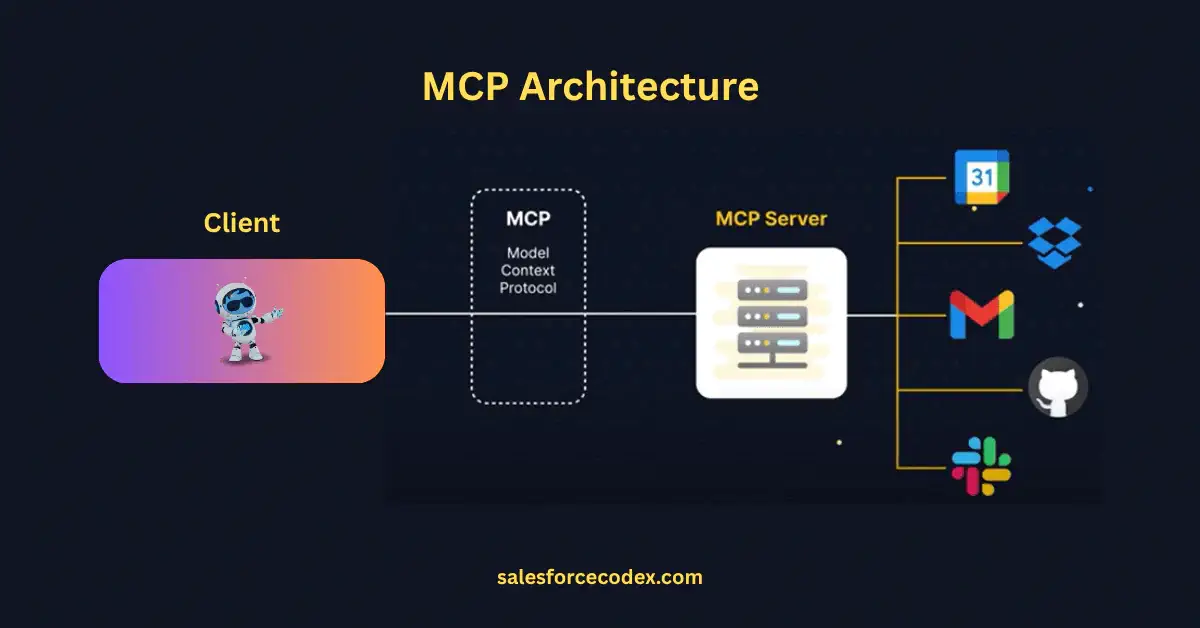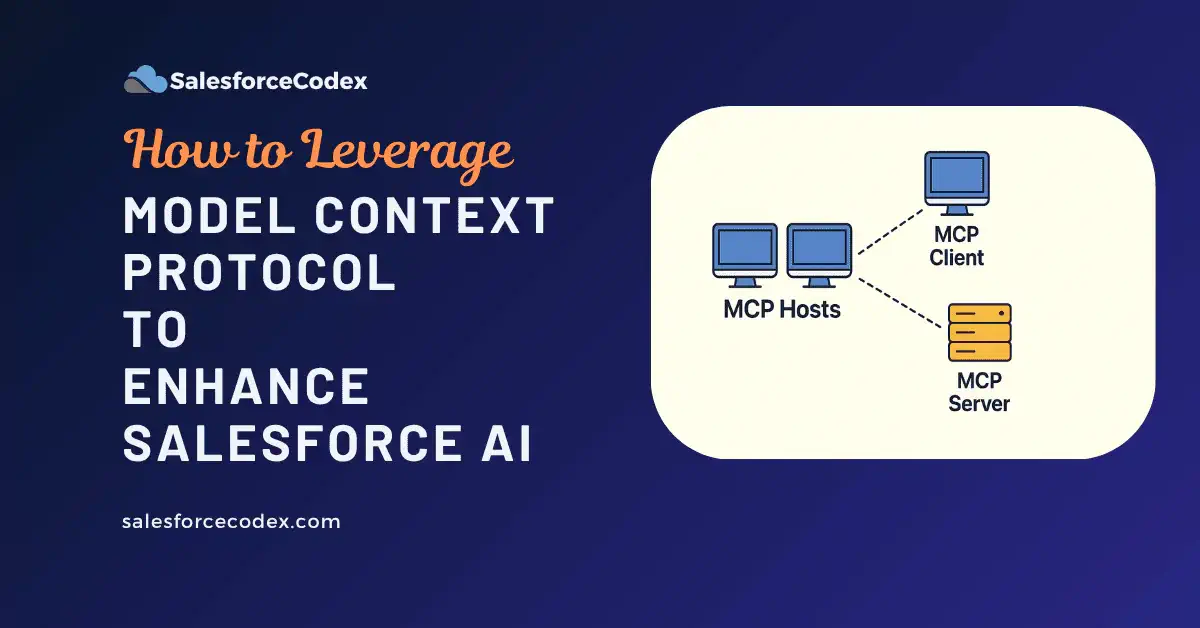In today’s AI-powered service world, businesses rely on systems like Salesforce to streamline operations and deliver personalized customer experiences. Tools like Einstein AI and Agentforce help automate jobs and offer smart insights. However, to work effectively, these devices need real-time data from many sources. That’s where the Model Context Protocol (MCP) can be useful.
Model Context Protocol (MCP) is an open standard that acts like a universal port for AI systems, permitting them to work smoothly with other tools and data platforms. In this post, we clarify what MCP is, how it fits into Salesforce, and why it’s a big step towards making Salesforce AI smarter.
What is Model Context Protocol (MCP)?
Model Context Protocol (MCP) is an open-source protocol that makes it easier for AI apps to connect with outside data and tools. It was launched by Anthropic in November 2024. We can assume it’s like a USB-C port for AI. It will change the need for customized integrations for every system.
With MCP, AI systems can:
- Access Data Seamlessly: Connect to any databases, CRMs, or APIs to fetch real-time information.
- Perform Actions: Execute tasks like updating records or sending messages.
- Ensure Security: Use standardized protocols like OAuth for secure data access.

MCP operates on a host–client–server model.
- MCP Hosts: These are the AI devices (like Agentforce in Salesforce) that need data or want to act. Example: Salesforce Agentforce wants to fetch client info from Google Drive or update a lead status in Slack.
- MCP Clients: It is middleware that receives the request from the MCP Host, converts it to a standard MCP format, and sends it to the appropriate MCP Server. Example: An Agentforce MCP Client sends the request “Get contract from Google Drive” to the Google Drive MCP Server in the correct format.
- MCP Servers: It is a lightweight API layer that connects to an external app/tool and executes the request or retrieves the data. A Google Drive MCP server fetches the latest contract file and returns it to the MCP client.
By simplifying how AI connects to other devices, MCP helps AI to be more context-aware, responsive, and actionable.
Why MCP is a Game-Changer for Salesforce
Salesforce is the best at customer relationship management (CRM). Its AI products, such Einstein AI and Agentforce, help businesses automate sales, marketing, and customer service. But these systems often need to get data from other platforms, including marketing tools and ERP systems, or do things across several apps. Traditionally, this needed custom API integrations, which took a lot of effort and were prone to making mistakes.
MCP changes this by giving Salesforce AI a standardized framework to interact with external systems. Salesforce just added MCP support with Agentforce 3 and MuleSoft’s Anypoint Platform. This means that developers can now:
- Develop pre-built MCP servers for jobs like code deployment and SOQL queries
- Use MuleSoft to convert existing APIs right into MCP-compatible ones
- Apply enterprise-grade security with governance tools like Agentforce’s policy enforcement.
This makes Salesforce AI smarter by enabling it to access richer context, automate a lot more complicated tasks, and deliver smarter insights.
Benefits of MCP in Salesforce
Below are some key ways MCP enhances Salesforce AI:
- Enhanced Data Accessibility: MCP helps Salesforce AI to pull data from external systems (e.g., marketing platforms, inventory databases) in real time. This will enable businesses to make more informed decisions.
- Streamlined Workflows: AI agents can perform multi-step tasks, like updating a Salesforce record, sending a Slack message, and scheduling a follow-up, all through a single message.
- Unified Tools: MCP helps different teams work together by linking Salesforce with other business tools, so everyone stays connected and shares information easily.
- Smarter AI Assistants: With accessibility to different data sources, Salesforce AI can provide contextually relevant suggestions, such as recommending next steps in a sales pipeline.
- Increased Responsiveness: MCP lets Salesforce AI get data instantly, so it can react quickly to changes in the market or what customers need.
AI-Powered Case Prioritization in Salesforce using MCP
Scenario:
A company uses Salesforce Service Cloud to manage customer support cases. They want urgent customer issues to be automatically prioritized using AI.
MCP-Powered Workflow:
- Customer submits a support ticket via Slack or Email.
- MCP (Model Context Protocol) captures the context of ticket-like message content, customer history, tone, and urgency level.
- MCP sends the data to the AI application, which uses sentiment analysis and past interaction data to determine urgency.
- AI scores the case (e.g., Critical, High, Medium, Low).
- MCP sends the result back to Salesforce, updating the case record with the priority and recommended next action.
- Salesforce triggers a flow to:
- Notify the support agent.
- Assign the case to the right queue.
- Start an SLA timer based on priority.
Real-World Applications
The integration of MCP with Salesforce unveils thrilling opportunities:
- Customer Support: A chatbot powered by Agentforce can retrieve customer data from Salesforce, support tickets from Zendesk, and check previous communications from Slack to expedite issue resolution.
- Marketing Automation: Einstein Real-time campaign data can be extracted from external platforms, allowing for dynamic adjustments to marketing workflows.
- Development Efficiency: The MCP servers enable users to deploy code or create scratch orgs using natural language, making development tasks more efficient.
Challenges and Considerations
Although MCP offers significant capabilities, there are some challenges to keep in mind:
- Security: Enterprises must ensure MCP servers adhere to strict access controls and use protocols like OAuth to protect sensitive data.
- Adoption: Developers need to learn MCP’s architecture and SDKs, which may require training. This will help them in career development.
- Scalability: With the increasing adoption of MCP by various tools, managing multiple servers and ensuring performance will be critical.
Salesforce can handle these issues with Agentforce’s governance tools and MuleSoft’s scalable infrastructure, but organizations should plan for robust implementation strategies.
Summary
The Model Context Protocol (MCP) is changing the way Salesforce AI works with the broader business ecosystem. MCP makes Salesforce AI smarter, more responsive, and more useful by giving it a standardized, safe, and scalable mechanism to connect to outside tools and data. MCP gives you the tools you need to get the most out of Salesforce’s AI features, whether you’re a sales rep making client interactions easier or a developer creating bespoke integrations.
Ready to dive into MCP?
Check out the official MCP documentation and explore Salesforce’s Agentforce 3 to start building smarter AI workflows today!
Need help in building Salesforce AI Agents?
Contact us at salesforcecodex@gmail.com with your use case or order at Fiverr (Hire Agentforce AI and Data Cloud expert).
Sources:
- Model Context Protocol
- Introducing MCP Support Across Salesforce
- MuleSoft’s MCP Support Announcement

